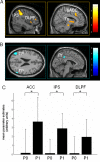Baseline brain activity fluctuations predict somatosensory perception in humans
- PMID: 17616583
- PMCID: PMC1924544
- DOI: 10.1073/pnas.0611404104
Baseline brain activity fluctuations predict somatosensory perception in humans
Abstract
In perceptual experiments, within-individual fluctuations in perception are observed across multiple presentations of the same stimuli, a phenomenon that remains only partially understood. Here, by means of thulium-yttrium/aluminum-garnet laser and event-related functional MRI, we tested whether variability in perception of identical stimuli relates to differences in prestimulus, baseline brain activity. Results indicate a positive relationship between conscious perception of low-intensity somatosensory stimuli and immediately preceding levels of baseline activity in medial thalamus and the lateral frontoparietal network, respectively, which are thought to relate to vigilance and "external monitoring." Conversely, there was a negative correlation between subsequent reporting of conscious perception and baseline activity in a set of regions encompassing posterior cingulate/precuneus and temporoparietal cortices, possibly relating to introspection and self-oriented processes. At nociceptive levels of stimulation, pain-intensity ratings positively correlated with baseline fluctuations in anterior cingulate cortex in an area known to be involved in the affective dimension of pain. These results suggest that baseline brain-activity fluctuations may profoundly modify our conscious perception of the external world.
Conflict of interest statement
The authors declare no conflict of interest.
Figures



References
Publication types
MeSH terms
LinkOut - more resources
Full Text Sources
Other Literature Sources

